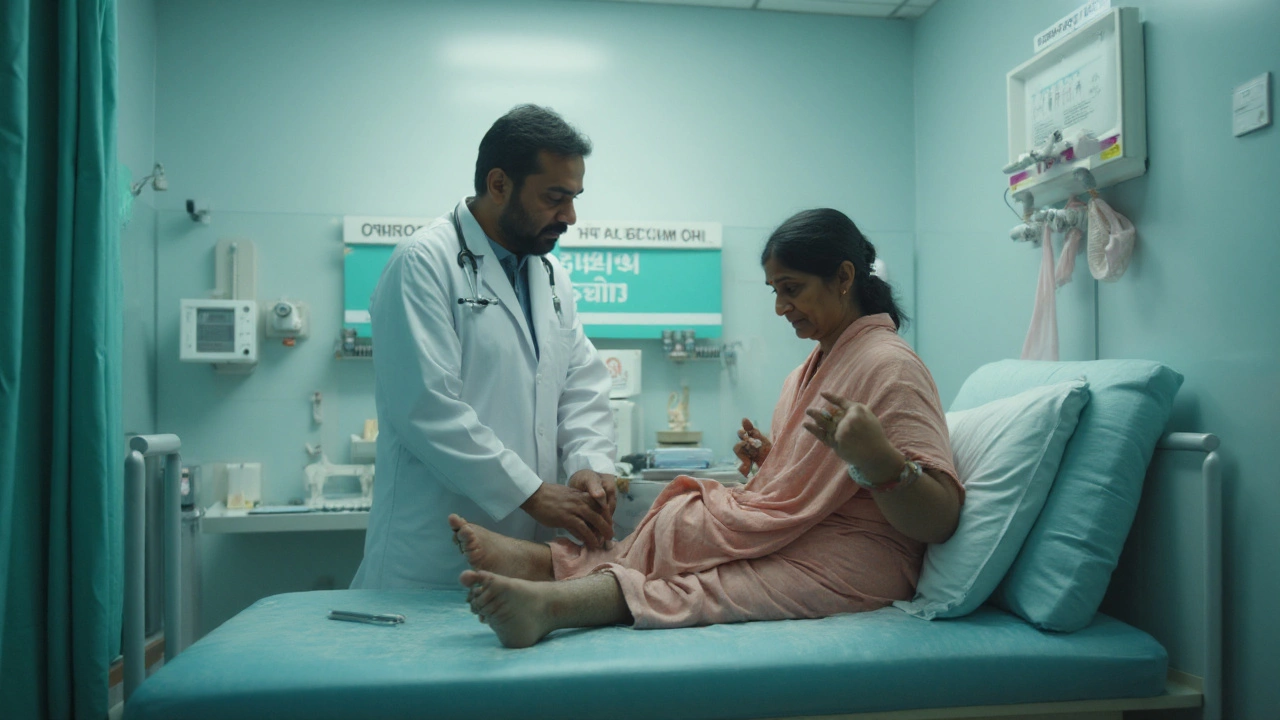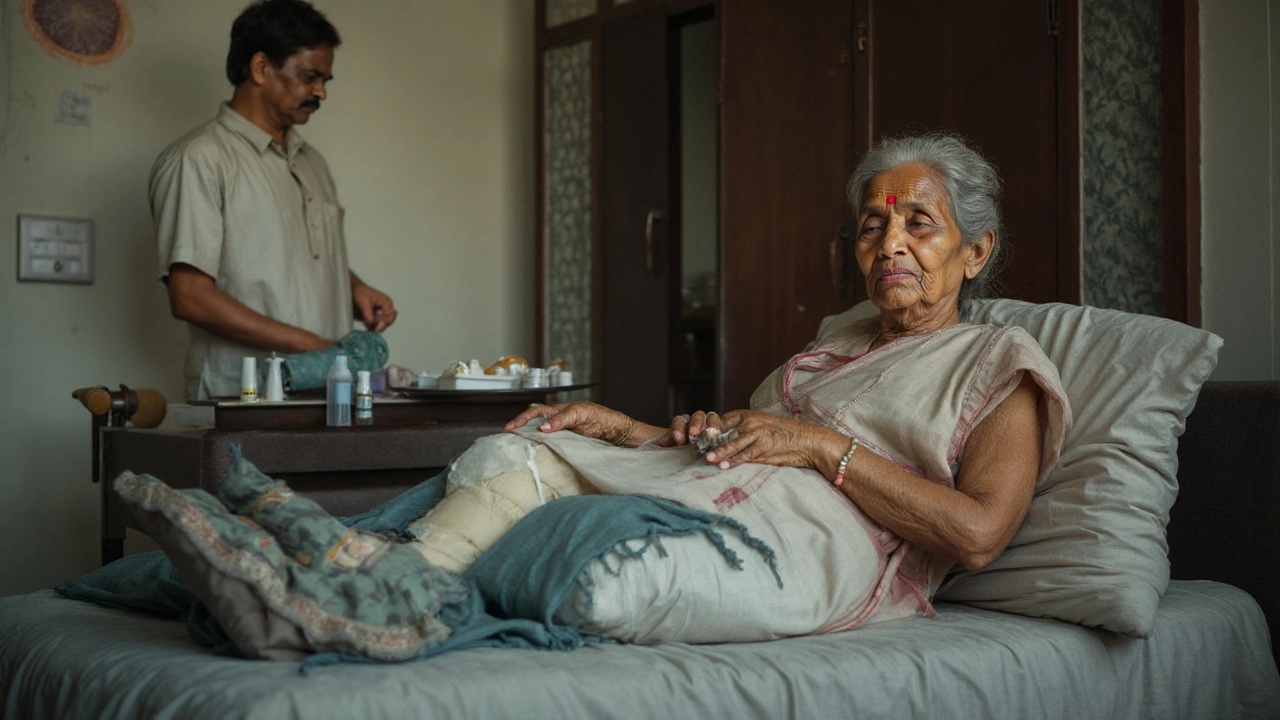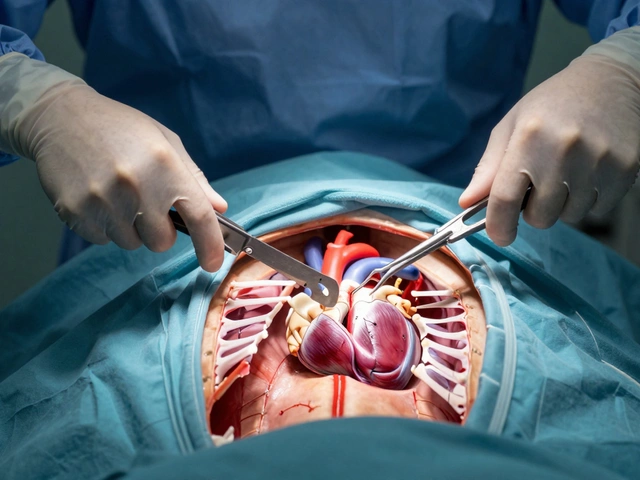The sting that surprises most people after knee replacement isn’t just the skin cut. It’s the deep, bruised ache in the thigh from the tourniquet, the tight band feeling across the kneecap, and the sharp pull when you first straighten or bend. Nights can be the toughest. Here’s the honest version of what usually hurts, when it peaks, and what actually helps.
TL;DR: What hurts most and when
- First 72 hours: A deep thigh ache (from the tourniquet) often beats the knee incision in terms of pain. Swelling builds and makes the knee feel like it’s under high pressure.
- Week 1-2: Front-of-knee pain when bending and a tight “strap” feeling across the joint. Night pain is common. Short, electric “zingers” from healing nerves can show up.
- Week 3-6: Stiffness replaces sharp pain. Outside-of-knee (IT band) or kneecap pain with stairs is typical. Sleep starts to improve.
- What’s normal: Soreness after physio that settles within 24-48 hours, mild bruising, temporary skin numbness, swelling that slowly trends down.
- Red flags: Fever, spreading redness, wound drainage after day 5, calf swelling and pain, sudden shortness of breath or chest pain. These need a call or urgent care.
Bottom line: The worst pain window is usually days 1-3, nights are hardest in the first two weeks, and steady improvement wins after week 3 if you stick to meds, icing, elevation, and gentle but regular movement. If pain ramps up instead of down, or you see red flags, call your surgeon.
Where the pain comes from: a simple map
You’re not just dealing with a cut on the skin. The surgery resurfaces bone, moves the kneecap, and the team often uses a tourniquet on your thigh to limit bleeding. All of that adds up to different pain sources that peak at different times.
- Thigh pain (days 1-3): Feels like a hard bruise or cramp. It’s from the tourniquet and muscle handling. Commonly worse than the skin incision early on.
- Front-of-knee pain (week 1-4): Shows up when you bend, do heel slides, or get up from a chair. This is the quadriceps tendon, patellar tendon, and kneecap area complaining.
- Deep pressure from swelling (week 1-2): The joint fills with fluid. It feels like a tight band around the knee, and the skin can look shiny.
- “Zingers” or burning (any time in first 6 weeks): Short, sharp nerve pains as tiny skin nerves wake up. They’re brief and random.
- IT band and outer-knee pain (week 3-8): As you walk more, the tissues on the outside of the knee work harder and can get sore.
- Calf tightness (week 1-2): Often from walking differently and swelling. Important to rule out a clot if it’s one-sided, hot, and tender.
Here’s a quick cheat sheet you can screenshot:
| Pain source | Feels like | Worst when | Best quick fix |
|---|---|---|---|
| Thigh (tourniquet) | Deep bruise, heavy ache | Days 1-3, getting up | Ice on thigh, gentle quad sets, scheduled paracetamol |
| Front of knee | Sharp pull, sting on bend | Heel slides, stairs, low chairs | Warm-up then bend, raise seat height, ice after |
| Swelling pressure | Tight band, fullness | End of day, after sitting long | Elevate “toes above nose,” 20-minute icing |
| Nerve zings | Electric pricks, burning | Random, worse at night | Reassurance, gentle massage around (not on) the incision |
| Outer knee (IT band) | Line of soreness on outside | Long walks, side sleeping | Shorter, frequent walks; later, light IT band stretches |
| Calf | Tight, crampy | After sitting, dehydration | Ankle pumps, hydration; rule out clot if red/hot/tender |
Why trust this map? Big groups like the AAOS (2024 guidance), ERAS Society (2023), and the PROSPECT team (2023) all stress that pain after knee replacement is multi-source and changes over time. They also agree on using several small tools rather than one big painkiller to keep you comfortable and safe.
What’s normal vs not: a real-world pain timeline
Here’s how pain usually plays out if your surgery and recovery are on track. Everyone is different, but this is the pattern I see most in patients and caregivers here in India.
- Hospital to day 3: Nerve blocks numb the knee at first. As they fade in 12-24 hours, pain peaks. Thigh ache is common. Pain scores can hit 6-8 if meds are late or light. Moving to the edge of the bed and taking the first few steps hurts but pays off fast.
- Days 4-7: Swelling settles in. The knee feels packed. Bending past 60-75° stings. Nights can be rough because swelling pools when you lie down.
- Week 2: Pain starts to swap sharp for stiff. Many can bend 80-90°. Extension (getting the knee flat) can be the hardest and most important stretch. Skin numbness around the scar is normal.
- Weeks 3-4: Pain drops, stiffness leads. Stairs and low chairs fire up kneecap pain. You may walk with a stick outside. Night pain eases if you keep up with icing and elevation.
- Weeks 5-6: Most daily tasks are doable with mild soreness (1-3 out of 10). Driving an automatic car is often fine after week 4-6 if it’s your left knee and you’re off sedating meds. Right knee takes longer.
- Weeks 7-12: You’re building strength. You might still feel a “steel band” sensation when kneeling or squatting (many surgeons advise no deep squats long-term). After long days, the knee may swell but recovers overnight.
- Beyond 3 months: Many days are pain 0-2. Sharp zingers fade. If pain stays above 4 and messes with sleep after 12 weeks, get a review.
When to worry:
- Fever over 38.5°C more than a day or chills anytime.
- Wound drainage that is cloudy or persists after day 5, or redness spreading out from the scar.
- Calf pain with one-sided swelling, warmth, and tenderness (clot risk).
- Sudden shortness of breath or chest pain (call emergency).
- Pain is getting worse each day after week 1, not better.
These flags match what NICE and AAOS call out in their infection and clot guidance. Don’t wait and see-call your surgical team.

Relief that actually works: step-by-step plan
No single trick beats post-op pain. The best plan uses a few simple tools together, on a schedule. This is what large reviews (Cochrane 2023, PROSPECT 2023) back, and what most Indian hospitals follow in practice.
1) Medications: simple first, stronger only if you need
- Paracetamol (acetaminophen): Take it on schedule for the first 1-2 weeks (example: 1,000 mg every 6-8 hours; max daily dose depends on your liver and age-many surgeons cap at 3,000 mg/day). This sets the floor for pain control.
- NSAID/COX-2 (if your stomach/kidneys/heart allow): Etoricoxib or celecoxib can cut swelling pain. In India, etoricoxib 60 mg once daily for 5-10 days is common. Ask about a PPI (like pantoprazole) if you have acidity or ulcer risk.
- Nerve-pain helper at night: Low-dose pregabalin or gabapentin can calm burning and improve sleep for a short run. Not for everyone-drowsiness is common.
- Opioid “rescue” only: Tramadol or a short course of a stronger opioid for breakthrough pain, not round-the-clock. Keep doses low. Avoid if you can drive soon.
- Blood thinners: You may be on aspirin, rivaroxaban, or similar. Take them exactly as told. They don’t reduce pain but prevent clots.
Medicine rule of thumb: scheduled paracetamol + short NSAID course + ice beats chasing pain with opioids. If you’re diabetic, have kidney or heart issues, or are over 70, your doctor may change doses.
2) Ice and elevation: do it like a pro
- Ice 20 minutes, 5-6 times a day, and always after exercises or walks.
- Elevate “toes above nose” for 30-45 minutes, 3-4 times a day. Prop under calf and heel so the knee can straighten. Don’t leave a pillow under the knee for hours-it feeds stiffness.
- Use a cloth between skin and ice pack. Never put ice on bare skin or the fresh incision.
3) Move smart, not macho
- Early extension first: Work on getting the knee flat. Place heel on a rolled towel, relax the thigh, count 30-60 seconds. Repeat a few times a day.
- Heel slides to bend: Bend until it’s tight-but-tolerable, not a knife-sharp pain. Hold 5 seconds, repeat 10-15 times, 3-4 sets daily. Warm-up first (short walk or warm pack above the knee), ice after.
- Quad sets and straight leg raises: Squeeze the thigh, hold 5 seconds, repeat 10-20 times. If the leg lifts with a big wobble or pain, go back to quad sets and try again next week.
- Walk often, short distances: 5 minutes, several times a day beats one 30-minute march. Indoors on flat floor is fine at first; avoid pothole-heavy roads early on.
- Stairs mantra: “Up with the good, down with the bad.” Handrail always. A cane or crutch on the opposite side helps stability.
4) Sleep like it matters (because it does)
- Best positions: on your back with a pillow under calf and heel, or on your non-operative side with a pillow between knees. Don’t park a fat pillow under the knee all night.
- Bed routine: cool the room, ice 20 minutes before bed, light snack, no caffeine after noon. If night pain spikes, a gentle set of ankle pumps and quad squeezes can settle it.
- If you take a nerve-pain tablet at night, check with your doctor about driving the next day.
5) Little things that add up
- Compression stockings if advised by your team. They can help with swelling.
- Hydration and fiber: Pain pills plus dehydration equals constipation, which increases strain and pain. Add stool softener for a week if you use opioids.
- Protein target: 1.2-1.5 g/kg/day in the first month supports healing (think eggs, dal, paneer, lean meats). Vitamin C 500 mg/day for two weeks is often suggested.
- Home tweaks (India-specific): Use a western commode or a raiser, add a firm chair with armrests, pick a smooth taxi over a bumpy auto for follow-ups in the first 3-4 weeks.
- Wound care: Keep it clean and dry as advised. No creams or oils on the fresh incision unless your surgeon says so. A little clear or blood-tinged stain early is common; thick yellow or smelly fluid is not.
What the evidence says: Groups like AAOS (2024) and PROSPECT (2023) recommend a “multimodal” plan: paracetamol + NSAID/COX-2, nerve block during surgery (often an adductor canal block), local anesthetic in the joint, and ice/elevation. This combo lowers strong opioid use and improves early walking.
FAQ, checklists, and quick answers
Q: What hurts the most after knee replacement?
A: In the first 72 hours, the deep thigh ache from the tourniquet and the pressure from swelling often beat the incision pain. In weeks 1-3, bending and straightening are the most painful moments. Nights can feel worse than days.
Q: Why do I feel electric shocks or burning?
A: Tiny skin nerves were cut and are reconnecting. Short “zings” are normal for a few weeks. If burning is constant, intense, and skin is very sensitive, ask about a short course of a nerve-pain tablet.
Q: Is pain worse at night?
A: Often yes in the first two weeks. Swelling pools when you lie down. Ice before bed, elevate properly, and keep paracetamol on schedule. A small protein snack can help.
Q: How long till pain is manageable without strong pills?
A: Many can taper off strong meds in 3-7 days and use just paracetamol (and maybe a COX-2) after that. By week 3, most days are manageable with ice and light meds.
Q: My knee is more painful after physio. Bad sign?
A: Soreness for up to 24-48 hours after a hard session is expected. Pain that keeps climbing each day or brings new redness/swelling needs a check.
Q: Can I sleep on my side?
A: Yes, usually after the first week, with a pillow between your knees. If it hurts, switch back to your back for a few nights and try again.
Q: When can I drive?
A: Left knee plus automatic car: often 4-6 weeks if you’re off sedating meds and can do an emergency stop. Right knee or manual car: often 6-8 weeks. Always test braking in a safe, empty area first.
Q: Will I ever kneel or sit cross-legged again?
A: Kneeling can be painful even at 6 months; some adapt with a cushion. Sitting cross-legged or squatting is not ideal for most implants. Many surgeons advise avoiding deep squats long-term to protect the prosthesis.
Q: What about continuous passive motion (CPM) machines?
A: Big reviews don’t show strong long-term benefits. If you use one, it’s a supplement, not a replacement for active exercises.
Q: Are nerve blocks safe?
A: Adductor canal blocks are common and tend to spare quadriceps strength while reducing early pain. They usually wear off in a day.
Q: Why is my skin numb near the scar?
A: Small skin nerves are cut during surgery. A patch of numbness on the outer side of the scar is common and may shrink over months.
Practical checklists you can use today:
Pain control daily checklist
- Paracetamol on schedule (set alarms).
- NSAID/COX-2 if allowed, short course with stomach protection if needed.
- Ice after activity, 20 minutes, cloth barrier.
- Elevate 30-45 minutes, toes above nose.
- Walk short and often; do ankle pumps hourly when awake.
- Protein at each meal; 2-3 liters of water unless restricted.
- Track pain morning and night (0-10). Look for a downtrend week to week.
Red-flag checklist (call your team)
- Fever >38.5°C, chills, or feeling acutely unwell.
- Worsening redness or hot skin around the incision.
- Thick, cloudy, or smelly drainage after day 5.
- One calf bigger, red, hot, and tender.
- Sudden chest pain, breathlessness, or coughing blood (emergency).
India-specific home setup checklist
- Western toilet seat or raiser; avoid squatting.
- Firm chair with arms; raise seat height with a cushion.
- Non-slip bath mat; hand shower if possible.
- Remove loose rugs and clutter on the floor.
- Choose smoother taxi rides for follow-ups in the first month.
Next steps and troubleshooting for common scenarios
If pain spikes after a good day
- Step back for 24-48 hours: shorter walks, keep exercises gentle.
- Ice and elevate 4-6 times that day.
- Return to your basic med schedule. Most flares settle fast if you don’t push.
If bending is stuck under 80° at 2 weeks
- Prioritize warm-up, then heel slides with 5-second holds, 3-4 sets daily.
- Add stationary cycling with high seat, no resistance, 5-10 minutes (even rocking back and forth counts).
- Ask your physio about patellar mobilizations. If progress stalls by week 6, your surgeon may discuss options like a manipulation under anesthesia.
If the knee won’t straighten (extension lag >10° at 2 weeks)
- Spend more time with heel prop extension (30-60 second holds, multiple times daily).
- Avoid sitting with a pillow under the knee.
- Talk to your physio; early extension is the #1 priority for walking well.
If nighttime pain ruins sleep
- Move your last exercise earlier in the evening.
- Ice and elevate 45 minutes before bed.
- Consider a one-time night dose of paracetamol (within daily limit). Ask about a short course of a nerve-pain agent if burning pain dominates.
If you have diabetes
- Keep sugars in range; high glucose increases infection risk and pain.
- Check before adding NSAIDs if you have kidney issues.
- Protein at each meal; space walks after meals to help sugars.
If you live alone
- Set up a “recovery station” with meds, water, ice packs, and a phone reacher.
- Batch-cook simple high-protein meals (curd, dal, eggs, paneer).
- Arrange help for the first 3-5 days-especially for stairs and bathroom safety.
If work involves sitting long hours
- Stand or walk 5 minutes every 30-45 minutes.
- Footstool to elevate while seated helps swelling.
- Keep a cold pack handy for end-of-day icing.
If you’re worried the pain is “too much”
- Rate it morning and night for 3 days. If the evening number keeps rising, or new redness/fever appears, call your surgeon.
- Remember: the worst days are usually the first two to three. Each week should be a step better, not perfect-but better.
A quick note on expectations: People often expect a straight drop in pain. Reality is wavy: good day, bad day, two average days, then a win. As long as the weekly average trends down, you’re on track. Big groups like AAOS and ERAS say the same-track the trend, not a single bad day.
If you want one simple phrase to keep you steady: protect the joint, move often, and chill the swelling. Do those three and your knee replacement pain will usually follow the normal curve-sharp early, then better by the week.






